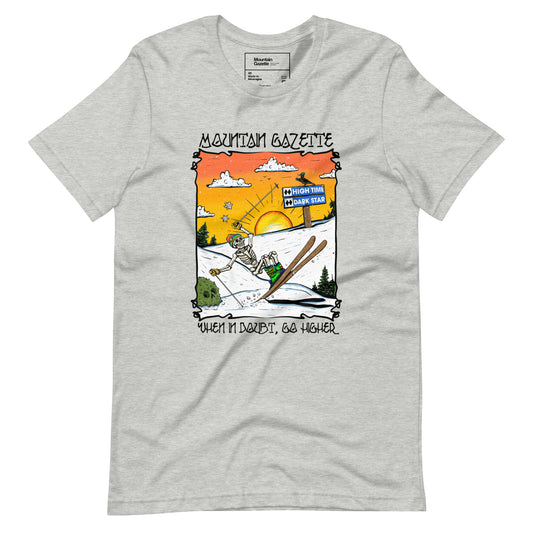The highway that keeps falling into the ocean
This article was originally published in the Here & There newsletter by Kyle Frost. Here & There is now Mountain Gazette's weekly Thursday newsletter.
Well, it happened again. Another stretch of Highway 1 in Big Sur collapsed, closing the highway indefinitely. While a single lane has re-opened to let tourists escape and accommodate local traffic, it’s a development that will hamper access and visitation for a significant amount of time. Which, logically seems unsurprising, given how precariously Highway 1 winds along the Pacific coast. First opened in 1937, the idyllic drive has been emblematic of California’s natural beauty for nearly a century. And, it’s had problems for nearly that long. The highway has been fully closed 55 times due to rockslides, mudslides, and road collapses.

Nuanced reactions
Amongst Big Sur residents, reactions to the latest closure were mixed. Local Patte Kronlund summed up the crux of the issue well, saying “Yeah, it’s just us, all the visitors are gone! Then comes a moment of being somber – wait, no visitors, no work…It’s a balance. We need both.” (Monterey County Weekly). The 90-mile stretch of the highway between Monterey and San Luis Obispo has been emblematic of both our attempts to capitalize on beautiful places (regardless of logistics or side effects), and also our ability to completely overwhelm those places.
The reason for road issues is not a mystery. The dramatic cliffs of Big Sur draw tourists from around the world but aren’t a stable place to build a highly trafficked highway. Collapses, mudslides, and fires (most significantly in 2016), have always been an issue. Higher ocean temperatures can lead to atmospheric river events of increasing intensity hitting the California coast. California’s Climate Adaptation Strategy lists “Sea-level rise, coastal flooding, and erosion” as a key issue, noting that “rising water levels and increased storm activity will increase coastal erosion, impacting beaches and cliffs…a projected 31–67 percent of Southern California beaches are projected to be lost by the end of the century if adaptation actions are not implemented.” Amtrak’s Pacific Surfliner route between San Diego to San Luis Obispo faces similar challenges with coastal erosion – it has shut down a dozen times in the last 6 years.
On a similarly beautiful stretch of coastline north of San Francisco called the Lost Coast, plans for a coastal highway were abandoned when the northern sections of Highway 1 were being constructed because of the rugged nature and complexity of the landscape. As a result, the Lost Coast sees millions of fewer visitors each year, and it remains one of the most undeveloped and remote portions of the California Coast.

Closures have a large impact on the businesses of Big Sur and nearby Monterey. “Extended closures of Highway 1 to visitors have cost the region hundreds of millions of dollars,” said Sandy Huerta, See Monterey’s communications specialist. “The closure is not just about the economic impact from visitation, it’s also a major issue for the quality of life of residents — people’s jobs, education and livelihoods are impacted on both sides of the closure.” (Mercury News)Solutions to address the impact of coastal erosion range from “moving it more inland” to “building tunnels”, but it seems like there’s little real movement towards a more permanent solution. The current placement of the Highway is iconic, and it would be a tough sell for the region to move it inland. Although “total losses to Big Sur businesses since the latest slide have exceeded $1 million each day”, the overall revenues brought in by motorists who visit for the drive is significant, and has only increased in recent years.

Ever increasing popularity
Images of places like Pfieffer Big Sur and the Bixby Bridge have driven more and more visitors to the region. Recent estimates suggest over 7 million people each year drive the road, causing congestion and crowding issues – most visitors never leave the highway because there are only two paved access points into the inland mountains.
The surge in tourism has been a hot button topic in the region, particularly over the last several years. For the roughly 1800 residents, dealing with illegally parking, selfie wielding tourists each year is a massive frustration – and there’s no sign that visitation is slowing down. While tourism is a boon for local businesses, similarly to other towns like Moab and Joshua Tree, local and state tourism bureaus spend millions of dollars each year to attract these visitors whether locals want it or not.
A Big Sur Destination Stewardship Plan was adopted by Monterey County in 2020. It proposes a plan forward to manage visitation and guide future decisions. Not everyone is a fan. Tim Green, co-chair of Keep Big Sur Wild wrote at the time “Transportation studies and the Land Use Plan itself recognize that eventually Big Sur’s popularity will overwhelm the limited carrying capacity of highway one. We have arrived at that point. In order to maintain high accessibility and the quality of the visitor’s experience the traffic entering Big Sur needs to be regulated.”

No easy way out
Now, I’m not sure what the middle ground solution is here. However many suggestions in the plan seem to center around accommodating increasing levels of crowds, rather than truly ameliorating them.
Similarly, Ecuador recently increased the entry tax for the Galapagos in an effort to curb the impacts of overtourism. However, I don’t think an extra $100 on top of an already expensive trip for international visitors is likely to curb anything. Will it generate additional revenues to combat the impacts of tourism? Absolutely. Will it address the root causes of overtourism? Unlikely.
On March 25, Keep Big Sur Wild sent a letter to the Monterey County Planning Commission asking for a moratorium on building new visitor-serving lodging while amendments to the Big Sur Coast Land Use Plan are discussed. There is, of course, a challenging duality here. Big Sur is a microcosm of overtourism debates happening around the world. It’s a place that is almost wholly dependent on public visitation, but also wants to retain the character and natural landscapes that made it attractive in the first place.












